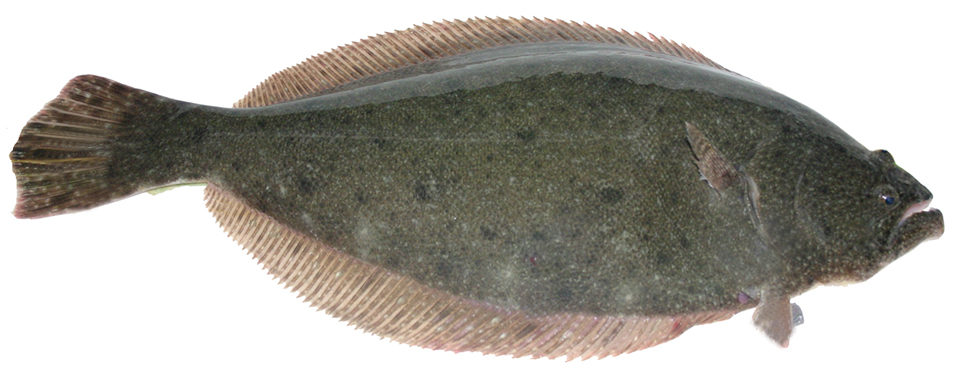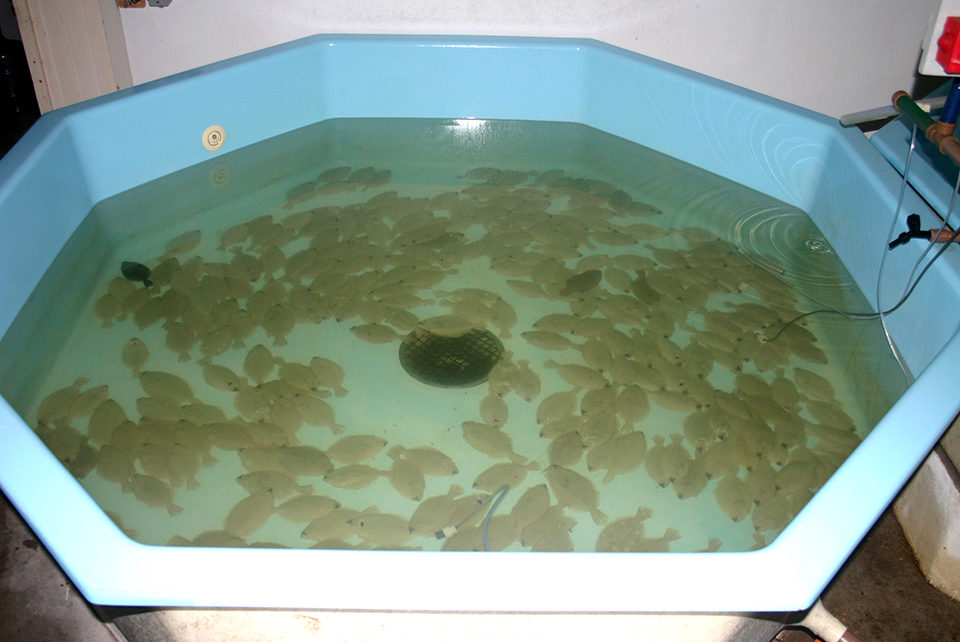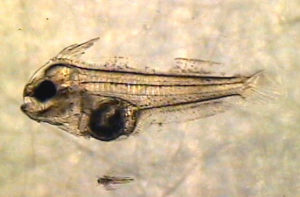Research on seedstock production, grow-out under way

In southern Brazil, one of the most valuable table fish is the southern Brazilian flounder (Paralichthys orbignyanus). The species is widely distributed from Mar del Plata in Argentina to as far north as Rio de Janeiro. Within this range, the Brazilian flounder faces natural water temperatures of 10 to 30 degrees-C during its extended spawning season, which lasts from mid-October in spring to late April in the fall. The southern Brazilian flounder is highly tolerant of water temperature and salinity fluctuations.
Because of local market demand and decreasing fisheries production, there is much interest in the development of commercial culture operations for the fish. The authors are conducting research to support the commercialization, including a program for the standardized production of quality fingerlings.
Reproduction
Brazilian flounder can be spawned naturally and induced. Considering their geographic distribution across a wide latitude range as well as their extended breeding season, it is likely the optimal temperature for natural spawning of Brazilian flounder is variable at different locations.
In Mar del Plata at 10 degrees south latitude, natural spawning is obtained when fish are kept at 19 to 20 degrees-C with a photoperiod of 16 hours light, eight hours dark. At Rio Grande’s 32 degrees south latitude, however, fish spawn at 23 degrees-C under 14 hours of light and 10 hours of darkness. This suggests that previous life history influences optimum temperature and photoperiod for reproduction, or there may be distinct populations of this species in the southwestern Atlantic Ocean.
Induced ovulation using hormones like luteinizing hormone-releasing hormone analogues, human chorionic gonadotropin or carp pituitary extract also results in high-quality eggs. Cryopreserved semen can be used to successfully fertilize manually stripped eggs. Dimethyl sulfoxide and glycerol are good cryoprotectants, accompanied by sucrose or saline diluent-based solutions, respectively.
Brazilian flounder females grow larger than males, so all-female, monosex production could be an advantage in commercial production. Some large-tooth flounders in the family Paralichthyidae, including the southern Brazilian flounder, have temperature-dependent sex determination. The authors’ preliminary results pointed to an almost 100 percent proportion of males when the fish were reared at 17 or 26 degrees-C, while at intermediate temperatures, there was a 50 to 60 percent proportion of females.

Larviculture, juvenile production
Newly hatched larvae need saltwater for proper development, but as soon as they settle to the bottom, they are ready to survive in freshwater. Larvae grow better at 23 degrees-C, but juveniles keep feeding in water from 12 to 33 degrees-C. These characteristics suggest success for rearing this species in southern Brazilian estuaries, where the water is typically cold and highly diluted during the rainy winter months but warm and salty during the dry summer.
Time for first feeding depends on the temperature. Brachionus plicatilis rotifers are first preyed on eight days after hatching at 17 degrees-C and four days after hatching at 23 degrees-C. Larvae are reared in “greenwater” populated with Nannochloropsis ocullata until artemia nauplii begin to be consumed two weeks after hatching at 23 degrees-C. Highly unsaturated fatty acid-enriched meta-nauplii provide better growth for newly metamorphosed larvae.
Weaning still is the most important challenge for reliable juvenile production. So far, juveniles can be fully weaned 45 to 60 days after hatching, but longer periods of cofeeding on dry diets can increase survival during early weaning. Taking into consideration survival and growth, the unit cost of production is reduced when juveniles are weaned 60 days after hatching.
Environmental factors such as temperature, salinity and light play important roles in the early development of fish larvae. The optimum temperature for rearing Brazilian flounder larvae is 23 degrees-C, but it can be raised to 26 degrees-C after metamorphosis to improve growth rate. Higher temperatures should be avoided because fish reared at 29 degrees-C show high mortality and poor growth.
Incubation and larval rearing should be carried out in saltwater, but after metamorphosis, salinity can be reduced to 10 ppt to improve growth rates. There is also a change in the optimum photoperiod for larval and juvenile growth. Larvae should be reared under continuous light, while after settling to the bottom, juveniles benefit from six hours of darkness per day.
Grow-out

The authors also evaluated the effects of salinity on the growth of Brazilian flounder during long-term experiments. The salinity tolerance of the fish was confirmed, as survival was not affected by low salinities. However, growth was enhanced when flounders were reared in brackish or saltwater instead of freshwater.
Oxygen consumption and ammonia excretion measurements made after long-term exposures to low and high salinities revealed that flounder can consume more oxygen and excrete less ammonia when reared in saltwater. These combined results suggested that the food consumed by flounder in saltwater is absorbed more efficiently, supporting the build-up of muscle mass and contributing to environmental responsibility by reducing releases of nitrogenous wastes.
Different growout runs carried out at indoor facilities have produced contrasting results. Different stocking densities have been used, mostly 10 to 38 kg per square meter. The time for fingerlings weighing 10 to 50 grams to reach 500 grams varied from eight to 13 months. The authors believe these variable outcomes reflected the wild origin of the broodstock used to produce the fingerlings. Higher and more standardized growth rates for Brazilian flounder are expected, once F1 fingerlings are produced.
(Editor’s Note: This article was originally published in the May/June 2009 print edition of the Global Aquaculture Advocate.)
Now that you've finished reading the article ...
… we hope you’ll consider supporting our mission to document the evolution of the global aquaculture industry and share our vast network of contributors’ expansive knowledge every week.
By becoming a Global Seafood Alliance member, you’re ensuring that all of the pre-competitive work we do through member benefits, resources and events can continue. Individual membership costs just $50 a year. GSA individual and corporate members receive complimentary access to a series of GOAL virtual events beginning in April. Join now.
Not a GSA member? Join us.
Authors
-
Dr. Luís André Sampaio
Federal University of Rio Grande
Institute of Oceanography
Laboratory of Marine Fish Culture
C.P. 474
Rio Grande – R.S.
96201-900 Brazil -
Marcelo H. Okamoto, M.S.
Federal University of Rio Grande
Institute of Oceanography
Laboratory of Marine Fish Culture
C.P. 474
Rio Grande – R.S.
96201-900 Brazil -
Andréa F. Rocha, M.S.
Federal University of Rio Grande
Institute of Oceanography
Laboratory of Marine Fish Culture
C.P. 474
Rio Grande – R.S.
96201-900 Brazil -
Ricardo V. Rodrigues, M.S.
Federal University of Rio Grande
Institute of Oceanography
Laboratory of Marine Fish Culture
C.P. 474
Rio Grande – R.S.
96201-900 Brazil -
Dr. Adalto Bianchini
Federal University of Rio Grande
Institute of Biological Sciences
Rio Grande, Brazil -
Dr. Ricardo B. Robaldo
Federal University of Pelotas
Institute of Biology
Department of Physiology and Pharmacology
Pelotas, Brazil
Tagged With
Related Posts

Health & Welfare
Dietary organic acids improve gut health, disease resistance in olive flounder
A study evaluated the effects of two organic acid blends on performance, gut health and disease resistance in olive flounder. The dietary organic acids were effective in lowering total gut bacterial counts, gut Vibrio counts and in conferring resistance against Edwardsiella tarda.

Health & Welfare
Korean researchers study protein levels, P:E ratios in olive flounder diets
The authors conducted research to determine the optimum dietary protein levels and protein:energy ratios for different age groups of olive flounders.

Responsibility
Southern flounder culture at Texas Parks and Wildlife Department
The Texas Parks and Wildlife Department’s southern flounder stock enhancement has stocked more than 400,000 fingerlings into Texas bays and estuaries.

Innovation & Investment
Aquaculture Exchange: Daniel Benetti
University of Miami professor says the U.S. seafood marketplace needs to embrace 'plate-sized' fish if a domestic aquaculture industry is to become sustainable and profitable.


